Last week I began profiling America’s celebrity photographer Annie Leibovitz for my Artist of the Week series. Over time, as the post grew longer and longer, I realized I was going to have to split it over two posts.
While I haven’t done that before—even when chronicling the work of some exceptional artists and photographers—I did it this time for two reasons: 1) the wide range of Annie’s work and 2) because she is still living and creating, something I believe is more instructive than reviewing the work of deceased masters. Her work has evolved significantly since her late 1960s art-school education and early photojournalism and continues to evolve, as you’ll see below.
If you only know Annie’s celebrity portraiture, the next section will come as a surprise.
Annie Leibovitz: On Reportage and War
In her book At Work, Annie writes: “In 1990, when I was preparing for the first major retrospective of my photographs, I went through thousands of pictures and discovered that the early reportage meant the most to me. I longed to go out into the world again with a little 35mm camera and look for a story…” (p. 102) She ended up in Sarajevo during the summer of 1993, documenting the conflict there. The resulting images don’t seem to appear on web searches, so here is a spread from her book:
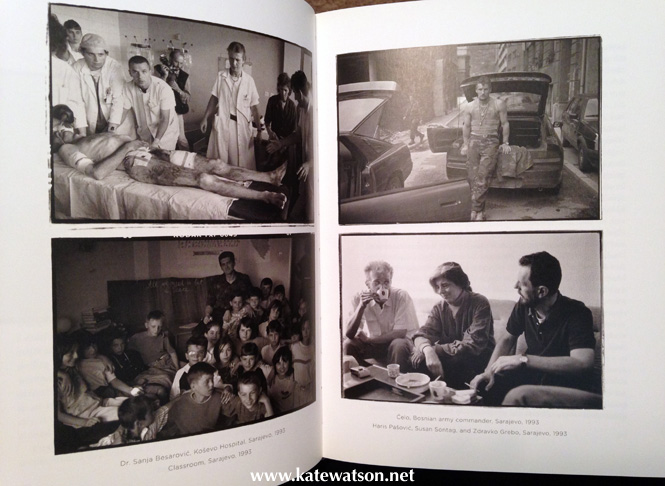
Spread from Annie Leibovitz At Work (c) Annie Leibovitz – Sarajevo 1994
-
Annie Leibovitz and Fashion
As you can see, Annie Leibovitz’s career has been quite diverse: photojournalism, portraiture, fashion… What is she most known for? Arguably, celebrity portraiture but even that crosses editorial and advertising arenas.
Her first major couture shoot, she says, was for Vogue in 1999—relatively recent for someone shooting professionally since the 1970s. “Putting together a shoot like this is not dissimilar to making a small movie,” she says. “You have to have everything planned before you get on the set…
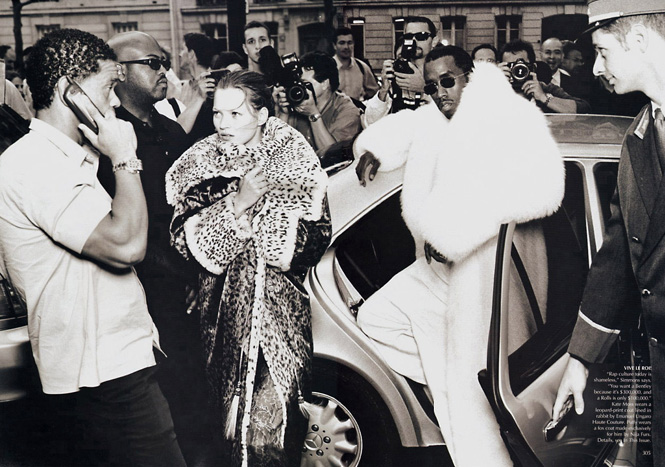
Annie Leibovitz for Vogue 1999: Puff Daddy and Kate Moss
“When I’m shooting, I use a storyboard with thumbnail pictures so that I can make sure that people are in the appropriate place in the photograph in terms of how it will look in the magazine.”
As you read these words, you can see their relationship to her latest work, both editorial and advertising:

Annie Leibovitz for Vogue 2005: “Beauty and the Beast” with Drew Barrymore

Annie Leibovitz for Vanity Fair 2007 – with Jennifer Connelly, Alec Baldwin & Aaron Eckhart
The following image of Jessica Chastain is part of Annie’s Disney Dream Portraits series. (There is a whole collection of accompanying behind-the-scenes videos for those curious.)

Jessica Chastain as Merida for Disney, by Annie Leibovitz 2014
When I look at the Dream Portrait above and its accompanying video, I’m struck by how like filmmaking Annie’s current process is and how removed from reality each image has become. It makes me question the boundaries between filmmaking and still photography, art direction and reality, and creating an image versus capturing it. What about you? If you watch the video, note the stand-in horse and the after-image addition of the background…for just two examples.
In the earlier fashion photography above, reality still exists although it is highly controlled. In this latest series, does reality exist? I’d love to hear your thoughts below.
Annie Leibovitz: On Her Work
Before we wrap up this tour through Annie Leibovitz’s archives, I’d like to share some of her random thoughts about her work:
“As much as I love pictures that have been set up, and as important as those pictures are to me, I’d rather photograph something that occurs on its own. The tension between those two kinds of photographs is at the heart of what I do.” (p. 158)
The above is an interesting quote for me because, when I look at Annie’s work, what I see is carefully crafted images with exceptional lighting. Maybe not in her reportage and earlier work, but recently. Didn’t we just talk about that in the section on her fashion photography? Isn’t it interesting that she says she’d rather photograph something naturally occurring?
But here’s something on which we totally agree:
“There are not many smiling people in my pictures. I’ve never asked anyone to smile. Almost never… Where did ‘Smile for the camera’ come from? It’s a tic. A way of directing attention to the camera. ‘Look at the birdie.’ The smile is a component of family pictures. Mothers don’t want o see their children looking unhappy… It took me years to understand that I equated asking someone to smile with asking them to do something false.” (p. 168)

Meryl Streep, Force of Nature for Vogue January 2012 by Annie Leibovitz
And one more on working digitally:
“I was afraid to start working digitally,” she says in the section of her book about the 2007 Vanity Fair shoot (shown above). “It was a whole new world. And in the beginning it meant working with more people. It was a tough transition. The digital technicians weren’t patient with my film assistants. There were a lot of fights.
“The digital guys though they were superior to the film guys, and the film guys thought the digital guys were acting like smartypants. The digital guys made it sound like it was all smoke and mirrors. But I learned to love digital. The technology has transformed the way we work. The more I use it the more I appreciate the possibilities.”
And doesn’t that sum up Annie’s latest work and the state of the industry?!
For more about Annie’s process and the 10 questions people ask her most frequently, including “What advice do you have for a young photographer who is just starting out?,” check out her book At Work. As I said in my prior post, I own others of her books but At Work is my favorite because it tells her story in her own words.
As noted above, I’d love to hear your thoughts on the blurring of reality, and filmmaking and photography, in Annie’s latest work or hear what you think her style is. Please share in the comments.
Cheers,









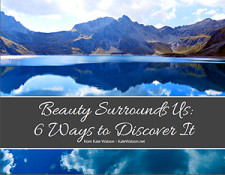
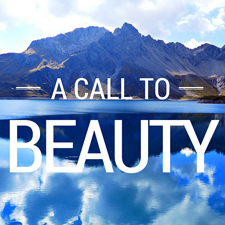
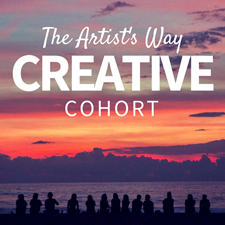
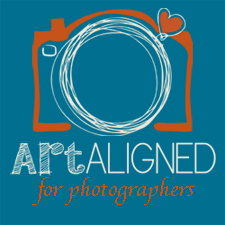






Artist of the Week: Annie Leibovitz » KateWatson.net - […] tuned for part two of Annie Leibovitz, next […]